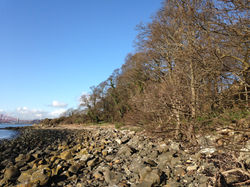Dalgety Bay Community Woodlands Group

 |  |  |  |  |  |  |
|---|---|---|---|---|---|---|
 |  |
What can I see in the Woods?
Like the old song about going down to the woods today.......
As we learn more about the wildlife in the woods, we will do some profiles on them,
just to highlight how important they are to the planet, the local area, wood and actually to us
as humans.
Wildlife
There is interest to be found in the woodlands at all seasons of the year, and winter, though
less colourful, can be when some wildlife becomes easier to see. But it in the spring that the
woods are at their best with many flowers blooming before the leaf cover on the trees blocks
out too much of the light. All three woods contain extensive stands of Native Bluebells
(Wild Hyacinth), though there are a few Spanish and Hybrid Bluebells close to some gardens.
The areas occupied by Native Bluebells, which are flowers of special conservation interest,
have diminished as bramble and ivy ground cover has increased. Effective management of this
ground cover should prevent further loss.
At least as important as the woods themselves are the woodland margins and the grassy
spaces that adjoin all of these woods. The greater light penetration in these areas means that
different plant species can flourish and the clear spaces mean that birds such as Kestrel and
Sparrow Hawk can hunt effectively, and those masters of nocturnal aerobatics, the Common
Pipistrelle bats, can chase after moths.
It is diversity in the species of trees, shrubs and other plants that is essential to maintaining both the interest of the woods for those walking through them and their value for the wildlife that people may be able to see or hear. Different trees and other plants support a wider range of insects, and it is these that provide the food for some of the different birds and bats that feed in and around the woods. Different fruits and seeds are also important both for other birds and the small mammals that will themselves be food for some of the top predators that we occasionally see.
It is not just the resident birds and mammals that make use of these woodlands, when you look at an aerial view of the area you can see that these three woods form part of an almost continuous corridor of woodland habitat stretching from North Queensferry through to Burnt Island. These habitat corridoors are essential for conservation and maintenance of species diversity as they allow for a greater movement of species through the woodlands and adjacent wild woodland edges and increase the overall size of the breeding populations. They are also an important staging post on the migration routes of some of the migrant birds that pass through the woods.
Two of the woodlands also serve to provide some protection to the the coastal areas on their southern flanks. This reduces the disturbance to the shore based wildlife, both resident seals and both resident and migrating seabirds and waders. Many species use these shores either to feed up as they undergo longer migrations, or to stay with us for the winter.
On the following pages, with links below, there is more information on some of the wildlife is using the woods and what you might be able to see and hear as you pass through.







